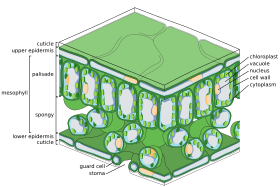
Back Blaar Afrikaans Blatt (Pflanze) ALS Fuella AN Lēaf ANG ورقة نبات Arabic পাত Assamese Fueya AST Laphi Aymara Yarpaq Azerbaijani یارپاق AZB





A leaf is a green above-ground plant organ. Its main functions are photosynthesis and gas exchange. A leaf is flat so it absorbs the most light, and thin, so that the sunlight can get to the chloroplasts in the cells. Most leaves have stomata, which open and close. They regulate carbon dioxide, oxygen, and water vapour exchange with the atmosphere.
Plants with leaves all year round are evergreens, and those that shed their leaves are deciduous. Deciduous trees and shrubs generally lose their leaves in autumn. Before this happens, the leaves change colour. The leaves will grow back in spring. Leaves are normally green in color, which comes from chlorophyll found in the chloroplasts. Plants that lack chlorophyll cannot photosynthesize.
Leaves come in many shapes and sizes. The biggest undivided leaf is that of a giant edible arum. This lives in marshy parts of the tropical rain forest of Borneo. One of its leaves can be ten feet across and have a surface area of over 30 square feet (~2.8 sq. metres).[1]
However, leaves are always thin so carbon dioxide can diffuse quickly to all cells.